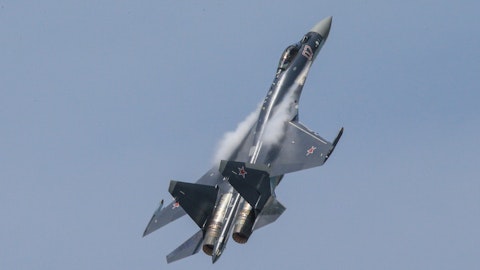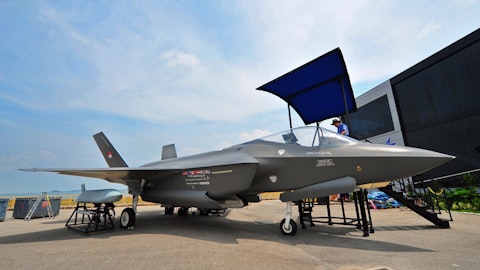Northrop Grumman Corporation (NYSE:NOC) Q4 2023 Earnings Call Transcript January 25, 2024
Northrop Grumman Corporation beats earnings expectations. Reported EPS is $6.27, expectations were $5.75. Northrop Grumman Corporation isn’t one of the 30 most popular stocks among hedge funds at the end of the third quarter (see the details here).
Operator: Good day, ladies and gentlemen. Welcome to Northrop Grumman’s Fourth Quarter and Year-End 2023 Conference Call. Today’s call is being recorded. My name is Josh, and I will be your operator today. [Operator Instructions] I would now like to turn the call over to your host, Mr. Todd Ernst, Vice President, Investor Relations. Mr. Ernst, please proceed.
Todd Ernst: Thanks, Josh. Good morning and welcome to Northrop Grumman’s Fourth Quarter 2023 Conference Call. This morning, we’ll refer to a presentation that is posted to our IR website. Before we get started, matters discussed on today’s call, including guidance and outlooks for 2024 and beyond reflect the company’s judgment based on information available at the time of this call. They constitute forward-looking statements pursuant to safe harbor provisions of federal securities laws. Forward-looking statements involve risks and uncertainties, including those noted in today’s press release and our SEC filings. These risks and uncertainties may cause actual company results to differ materially. Today’s call will include non-GAAP financial measures that are reconciled to our GAAP results in our earnings release. And on the call today are Kathy Warden, our Chair, CEO and President; and Dave Keffer, our CFO. At this time, I’d like to turn the call over to Kathy. Kathy?
Kathy Warden: Thanks Todd. Good morning everyone and thank you for joining us. Before discussing our 2023 results, I wanted to take a moment to thank our team for their hard work and dedication to our important mission. Our talented workforce which is now over a 100,000 strong continues to deliver some of the most advanced technologies in the world. These capabilities are used by our customer’s everyday to defend freedom and deter aggression around the globe. The geopolitical landscape has grown even more complex driving continued increases in global security spending. Our strategies has positioned us well to compete and win in this growing market which has translated into accelerating topline growth for Northrop Grumman. Revenue increased by over 7% in 2023 [indiscernible] more than a billion above the midpoint of our original 2023 guidance.
In addition, our book-to-bill for the year was 1.14 times, that’s in line with our exceptional four year average. As a result of this award strength, we achieved a new record backlog which now exceeds $84 billion and now provides a healthy foundation for our continued growth. The underlying performance of our company is strong. We generated free cash flow at the high end of our guidance range, and we comfortably exceeded our sales and EPS guidance range, absence of B-21 charge. While we’re disappointed that our assessment of conditions for the low rate initial production portion of the B-21 program necessitated this charge in the quarter, we are confident in our ability to deliver on the company’s forward outlook, which remains unchanged.
We’re also proud of the performance of the B-21 team, which continues to execute an unparalleled aircraft development program. As we look forward, we will continue to execute our business strategy, which at its core is based on technology differentiation, a laser focus on performance, and value delivery for our customers and shareholders. To support this strategy, we are prioritizing investment in our capacity and capabilities. In 2023, we invested over $2.9 billion in R&D and CapEx, that’s 7.5% of sales, to continue driving innovation and capacity to support our customer mission success. We also delivered over $2.6 billion to shareholders through dividends and share repurchases, representing a return of approximately 125% of our 2023 free cash flow.
So now I’ll highlight a few examples of progress we’ve made across the portfolio that further bolster my confidence in our future. Shortly after the close of the fourth quarter, we announced our GEM 63XL solid rocket boosters helped to successfully power ULA’s Vulcan launch vehicle on its first mission. Future Vulcan missions will utilize additional GEM 63XLs in support of Amazon, Kuiper, and other ULA customers, providing a significant growth opportunity for our propulsion business. And this is an important milestone because it supports our investment to significantly ramp production capacity of GEM 63s in the coming years. Global demand for our weapons system increased in 2023, and we expect this trend to continue. In this market, we’re both a supplier and a prime.
We’re a supplier of propulsion systems, warheads, fuses, and cannons across a highly diversified customer base, and a prime contractor for predominantly air-to-ground missiles, including AARGM, AARGM-ER, and Stand-in Attack Weapon. Weapons systems currently represents approximately 7% of total revenue, and based on the demands we’re seeing, we expect this business to grow faster than the company average for the foreseeable future, with a significant portion of this expansion coming from international customers. In our Mission Systems business, demand remains exceptionally strong, with a 2023 book-to-bill above 1.2 times, the highest of all of our segments. As we’ve seen in recent years, the restricted portfolio of Mission Systems is a meaningful driver of growth as our customers pursue solutions that enable them to operate inside the decision loop of potential adversaries who are also advancing their computing capabilities.
We are helping our customers stay ahead by developing advanced microelectronics, sensors, processors, and secure communication. Our product lines are enabling faster cycles of modernization, positioning our customers with decision advantage in this rapidly advancing technology environment. And we continue to make significant progress on the EMD phase of Sentinel, which is the next generation land-based leg of the strategic triad. We are achieving milestones to mature the design and reduce risk, including key test activities, such as the successful static fire test of the Sentinel Stage 2 solid rocket motor for the missile earlier this month. Last week, the Air Force submitted to Congress a new set of cost estimates for the program, which triggered a Nunn-McCurdy Breach.
This in turn launches a review of the program by the Department of Defense, which we expect to be ongoing for the next several months. It’s important to note that the cost growth is primarily driven by estimates for the command and launch facility build-out, which is part of the military construction and procurement phases of the program. We and our industry team are continuing to perform on the EMD phase in close partnership with the U.S. Air Force. And we’ll work with the government to explore opportunities to reduce costs on the program with a focus on the late 2020s and beyond when the program is expected to move into the procurement phase. And in the fourth quarter, the B-21 entered its flight test phase. This is a major milestone for the program and achieving it within the baseline schedule is a credit to the Northrop Grumman team and our close partnership with the U.S. Air Force over the past several years.
Following this milestone, we were awarded the first LRIP lot in the fourth quarter and production is now underway. Let me take a few moments to provide a little more detail on the B-21 charge. The possibility of which we started talking with you about at this time last year. As you know, like all of industry, we and our suppliers have experienced cost pressure from recent global macroeconomic conditions, which are significantly different from the assumptions the team made when bidding these five production lots in 2015. During the fourth quarter of 2023, we again reviewed our estimated profitability on the LRIP phase of the program. And we now believe it is probable each of the first five LRIP lots will be performed at a loss. The charge is largely driven by a change in our assumptions regarding funding to mitigate the impact of macroeconomic disruptions on the LRIP phase of the program and higher projected manufacturing costs that reflect recent supplier negotiations and our experience in completing the first aircraft.
The after tax cash impact related to these updates will be spread over a number of years. Importantly, we have absorbed this effect and we have not changed our outlook for free cash flow growth over the next several years. This is a game changing capability that will be of great value to our nation. And we are focused on executing the program in a way that also delivers value to our shareholders over the coming decades. Turning now to the budget environment. Global national security spending is increasing as the U.S. and allies invest in capabilities to deter and defend against aggression. Demand for our capabilities remain strong due to our differentiated portfolio and alignment to customer priorities including the triad, space and weapons.
In the U.S., our franchise programs remain well supported by Congress and the Department of Defense. And this gives us confidence in our outlook even in a constrained U.S. budget environment. We are pleased to have an NDAA in place that provides continued support for defense spending. And we’re hopeful that Congress will enact appropriations soon. Our guidance assumes we will not have a shutdown or a full year CR, and we’re encouraged by the progress we’ve seen so far towards passing appropriations in the March timeframe. Additionally, we are monitoring progress on supplemental funding and we see opportunities in expanding the industrial base and increasing munitions production in this pending request. Our allies are also increasing their defense spending and we expect our alignment with their needs for aircraft, weapon systems and mission systems to be an additional source of growth.
So as we look to the future, we have the right portfolio and team to deliver on our long-term outlook. Our organic sales have grown at a greater than 5% annual rate since 2019. And our guidance calls for continued growth of 4% to 5% in 2024. Segment operating margin dollars are expected to grow at roughly the same rate as sales in 2024. And our 2024 EPS guidance range of $24.45 to $24.85 at the midpoint represents roughly 6% growth excluding the B-21 charge and 11% growth compared to our initial EPS estimates which we provided for in 2023. In addition, the structural building blocks to expand our margins that we outlined in last year’s 2Q earnings call, including dissipating macroeconomic headwinds, implementation of productivity and cost savings initiatives and future favorable mix shift remain in place.

We are laser focused on performance and bid discipline to drive margin expansion. And importantly, we continue to expect our free cash flow to grow at a double digit rate over the coming years. We are reaffirming our 2024 and 2025 free cash flow outlook. And we’ve also introduced a 2026 outlook of $3.3 billion at the midpoint. With the businesses generating significant cash flow, we have considerable flexibility in deploying capital to generate value for customers and shareholders. Our top priority remains investing to support our business strategy. And we expect to invest over 7% of sales again in 2024 in capital expenditures and R&D. At the same time, we’ll continue to provide strong capital returns to our shareholders. Last month, our board of directors increased our share repurchase authorization by an additional $2.5 billion, and we ended the year with a remaining authorization of $3.6 billion.
For 2024, we expect to increase our share repurchases to at least $2 billion. This includes a $1 billion ASR that we plan to initiate in the coming days based on the strong liquidity position with which we entered this year. So when we take these factors, sustainable top-line growth with expanding margins, and couple those with declining capital intensity and lower projected cash taxes, you get a recipe for robust cash flow growth for years to come. So now I’ll turn it over to Dave to provide you more details on the segment results, 2024 guidance, and the forward outlook. Dave?
Dave Keffer: Thanks, Kathy, and good morning, everyone. We finished the year with strong momentum, enabling us to reaffirm and build upon our favorable forward outlook. I’ll start by elaborating on our 2023 results and then provide additional details on our guidance. On the demand side, we ended 2023 with over $84 billion in backlog, a new record for our company. All four of our segments generated a full-year book-to-bill ratio over one-time sales. We also continued to deliver strong top-line results with Q4 sales of $10.6 billion, up 6% compared to the fourth quarter of 2022. Full-year sales were even stronger, up over 7% at $39.3 billion, or roughly $300 million higher than our latest guidance. These top-line results were enabled not only by the strong demand environment we’re seeing among our customers, but also by our ability to ramp on new programs, expand our workforce, and convert our backlog into sales.
Moving to segment results, we generated sales growth in each of our businesses in 2023. Aeronautics sales were up 2% for the year, returning to growth earlier than previously expected. AS growth was driven by higher volume on restricted programs that more than offset declines on mature production programs. DS posted sales growth of 5%, led by higher volume in the weapons and missile defense portfolio. Mission System sales were also up 5%, driven by higher restricted sales on advanced microelectronics programs and higher volume on marine systems programs. And our space business posted another quarter of double-digit top-line growth, with sales up approximately 14% for the year. Nearly 40% of the growth came from Sentinel and NGI, with the rest coming from our broad space portfolio.
As Kathy described, our segment margins included a charge for the B-21 program. The charge was primarily driven by the confluence of lower assumptions around macroeconomic disruption funding and higher production cost projections. While the full pre-tax charge had the effect of lowering our segment margins, only $143 million has been recorded as an EAC adjustment, including a $43 million reduction to Q4 sales. The remaining was booked as a contingent liability because the majority of the lots have yet to be awarded. The charge also led to an $82 million benefit in corporate unallocated expense, stemming from a reduction in deferred state taxes. Continuing with our results, slide 5 shows a comparison of our 2023 earnings per share to the guidance we provided in October.
Diluted EPS includes a $2.08 unfavorable mark-to-market adjustment from our pension plans and a $7.68 per share impact from the B-21 charge. Absent these items, we would have exceeded the high end of our prior EPS guidance range by over $0.40. Our 2023 mark-to-market adjusted EPS also included significantly less pension income compared to 2022. In total, net pension costs generated a $4.07 per share headwind in 2023. Next, I’ll take a few moments to discuss our cash flows. As is our historical pattern, we had an outstanding quarter of cash performance in Q4, generating $1.6 billion in free cash flow. For the full year, our operating cash flow was $3.9 billion, and our free cash flow was $2.1 billion. This result was near the high end of our guidance range and represented free cash flow growth of 30% compared to 2022.
Turning to pension results, we generated strong asset returns of roughly 11% in 2023, ahead of our long-term assumptions. The FAS discount rate declined by roughly 40 basis points to 5.15%. Netted together, along with updated census data, this generated a mark-to-market pension expense of $422 million in our GAAP results. Slide 7 in our earnings deck summarizes our pension estimates for the next three years. We continue to expect CAS recoveries to increase from current levels, providing a benefit to our cash flows, but slightly less than prior projections. And we expect a higher level of non-operating FAS pension income in the coming years, driven by our strong asset returns in 2023. In total, our funded status remains superb at nearly 100%, and we continue to project minimal cash pension contributions over the next several years.
Turning to 2024, slide 9 in our earnings deck includes our segment-level guidance. Building off the strong top-line results in Q4, we now expect aeronautics sales in the low 11 billions, driven by growth on B-21 and on other programs such as F-35 and E-2D. This is higher than our prior sales estimates for AS, which reflected a flat 2023 and modest growth in 2024. Higher B-21 sales also result in a slightly lower margin rate expectation for AS, which we now project in the mid-9%, netting out to a similar volume of margin dollars compared to prior estimates. DS sales are expected to be roughly $6 billion, up low single digits from 2023. As we mentioned on the Q3 call, DS has really turned the corner on growth through strong demand for weapons and missile defense capabilities.
We are optimistic in our ability to convert these opportunities into sustained growth in this business over time, which we expect to be partially offset by modest declines in the sustainment and training portions of the business. Margins are projected to remain strong at DS in the low 12% range. Mission System sales are expected in the low to mid $11 billion range for another year of mid-single digit growth, with margins of roughly 15%. And that space, after expanding sales at a greater than 17% CAGR since 2019, growth is expected to moderate in 2024 with higher segment margins. Space sales are now expected in the mid-to-high $14 billion range, with margins of approximately 9%. The mid-single digit growth rate in space reflects declines in a restricted program due to shifts in government priority, which are more than offset by growth in other parts of the space portfolio.
Having built a tremendous backlog in recent years, space now has an opportunity to deliver strong ROI through more measured growth, along with margin expansion and cash generation. At the company level, our guidance reflects growth in sales and segment margin between 4% 5%, absent the B-21 charge, consistent with the outlook we provided on our October call, even after delivering top line upside in Q4. We expect another solid year of bookings, with a book-to-bill around one times. And similar to our cadence over the last few years, we expect sales to ramp throughout the year, with first quarter sales a little less than 24% of our full year estimate. We plan to be in the market soon for new debt issuance to take advantage of the favorable rate environment.
The proceeds from the debt issuance will also be used in part to support refinancings of $1.5 billion of notes that are coming due in January of 2025, as well as for general corporate purposes and share repurchases, including the $1 billion ASR we intend to initiate in the coming days. We’ve reflected this debt issuance in our interest expense guidance, and we’d also expect interest income to contribute to the EPS line, as it did in 2023. We project an effective tax rate of approximately 17% in 2024, consistent with the range we’ve experienced over the last few years, excluding the mark-to-market adjustment and other unique items. We’re coming closer to conclusions on a number of open audit and appeals processes with the IRS, which could have positive or negative effects on book and cash taxes as they’re resolved over the next couple of years, and our forward guidance does not include any such adjustments.
Similarly, we have not factored any potential changes to R&D tax legislation into our outlook. And as a reminder, our interpretation of current tax law results in a projected 5-year impact from R&D amortization of approximately $2 billion. We will continue to track these matters carefully and provide updates as they progress. In total, we expect our 2024 earnings per share to be between $24.45 and $24.85 on with approximately 148.5 million weighted shares outstanding. Moving to cash, we expect 2024 free cash flow between $2.25 billion and $2.65 billion consistent with our prior outlook. And as we’ve said before, capital expenditures are expected to remain elevated in 2024 before moderating in 2025 and beyond. Slide 11 in our earnings deck provides an update to our long-term free cash flow outlook to include 2026.
We continue to expect our free cash flow to grow at a double-digit rate for several more years with additional growth in the second half of the decade. This expansion will be driven by sustained growth in our business, generating strong operating margin volume and converting those profits into cash. Meanwhile, lower cash taxes, higher CAS recoveries and lower levels of capital spending in the coming years provide additional structural levers to expand our cash flows at a rapid rate. Importantly, these ranges also include the latest estimated cash impacts associated with the B-21 charge. We expect roughly 60% of the charge to affect cash flows through 2026 with the remainder in the following years. Longer-term, we are confident we’ll be able to continue to absorb the cash headwinds from B-21 while delivering excellent free cash flows in 2027 and beyond.
In closing, I want to thank the entire Northrop Grumman team for their contributions to another great year. The strength of our portfolio and visibility of franchise programs provides us the opportunity to deliver and deploy robust cash flows as we execute on our strategy. And with that, let’s open up the call to Q&A.
See also 30 Safest Cities in the World for Solo Female Travelers to Visit and 20 Countries That Produce the Most Oil In The World.
Q&A Session
Follow Northrop Grumman Corp (NYSE:NOC)
Follow Northrop Grumman Corp (NYSE:NOC)
Operator: Thank you.[Operator Instructions] Our first question comes from Kristine Liwag with Morgan Stanley. You may proceed.
Kristine Liwag: Hey good morning, Kathy and Dave.
Kathy Warden: Good morning.
Kristine Liwag: Kathy, on the B-21, you’ve been very clear about the pressures on this program. Ultimately, how much relief did the customer extend to you to offset macro pressures and elevate [ph] portion. And is there still a possibility of future relief?
Kathy Warden: So Kristine, we’ve been working with the customer. And as we noted, the conversations continue. And last year, in 2023, we and Air Force disclosed that about $60 million of $1.5 billion that Congress appropriated for inflation was allocated to the advanced procurement for Lot 1 on this program. But we have yet to work through what that relief may be in future lots. We have, of course, as we said, updated our assumptions — and through conversation and the tight budget environment, we’ve actually lowered the expectations for inflation relief. And so at this point, our focus is on executing this program and finding opportunities in the performance on the program while we continue to work with the government to see if there is any inflation relief opportunity.
Kristine Liwag: Great, thank you. And I’ll keep it to one today. Thank you.
Kathy Warden: Thank you.
Operator: Thank you. One moment for questions. Our next question comes from Richard Safran with Seaport Global. You may proceed.
Richard Safran: Kathy, Dave good morning. So I know you’re going to get a lot of questions on the B-21, but I thought I’d ask you about to expand on your opening remarks about Sentinel. I thought you might talk a bit more about the actions you’re taking at the program back on track. How are you seeing risk on the program right now? And I guess, importantly, what you think the government’s level support for the program is given all the headlines and what we’ve been seeing?
Kathy Warden: Yes. Thanks, Rich. So as the land-based leg of the nuclear triad, Sentinel is a top priority for the Department of Defense. The requirement for the program has been validated numerous times by multiple administrations, and we expect that to be the outcome of this latest review. As the Air Force is reported, the non-operating cost reach on the program is largely due to cost growth in the military construction and procurement segments of the program, and we and the industry team are currently executing on the cost plus EMD phase of the program. That’s important because our design work in this phase is helping the Air Force to better estimate the costs of those later phases and due to a number of factors of learning their cost estimates for these later phases have increased, and that’s what’s driving the non-[indiscernible] breach as the Air Force has said, growth on the EMD would not have triggered the breach.
I’ll also note that their update captures the inflation since 2020, the last time they did a cost estimate. And we all know that there’s been significantly higher inflation than what was assumed at that time. So some of that is what you’re also seeing reflected in these latest cost estimates. I mean with that said, though, you asked about our performance on the program, and I’m really pleased to report on the progress that our team has made over the last 3 years while we’ve been executing on the EMD phase. We’ve on boarded thousands of engineers. We’ve matured the system design. We’ve produced and tested critical hardware in the missile system, as I’ve outlined earlier on the call. We’ve also engaged in risk reduction, which is helping to inform the Air Force launch facility modernization and we’ve done all this while also doing detailed planning for the future phase of the program.
I myself have visited the missile fields actually, I was at one last Friday, which is part of why I’ve got this cold, I brought back. And I met with the Airmen [ph], who have committed themselves to this important mission. So we’re all in. We know how important this is our team is partnering closely with the Air Force, and we’re going to help them to deliver this essential capability for our nation.
Richard Safran: Thanks for that. Feel better.
Kathy Warden: Thank you.
Operator: Thank you. One moment for questions. Our next question comes from Ron Epstein with Bank of America. You may proceed.
Ronald Epstein: Hey good morning everyone. So maybe just jumping back to B-21. Charges like there’s some programs have a tendency to accumulate over time. They don’t tend to go the other way. How should we think about it as we go forward? I mean, this is what for the first 5 LRIPs, how many LRIPs could there be? And how do we think about the bounds on this? And then maybe one last thing. Is the program NPV positive and if it is, when does it actually become NPV positive, cash flow positive and so on and so forth. If you could just peel back the onion on the program.
David Keffer: Sure. I can go ahead and get started with that. And see if we can address a number of questions you raised. First of all, in terms of the future, we’ll continue to update our projections every quarter as we do with all of our large programs. But it’s important to note, we have a lot more information today than we did at this time last year, having completed the production in the ground test phase of the first aircraft. We also have the majority of the suppliers now under contract with the remaining in advanced stages of negotiations. We have our latest estimates for productivity and reasonable learning curves that we believe are appropriate based on our historical experience. Of course, we now have one lot under contract, and we’ll finalize quantities of the next four lots over time as well.
In the economy and inflationary factors have stabilized a bit over the past year, and we’ll continue to track those, of course, over time as well. But perhaps most importantly, we’re still performing well on this program, which is continuing to provide a critical capability for our customers. In terms of the long-term NPV, we think that’s the most important thing is that our customers will get great value from the aircraft. We’ll deliver them over time, and that should, over time, also lead to value for the company and our shareholders.
Operator: Thank you. One moment for questions. Our next question comes from Douglas Harned with Bernstein. You may proceed.
Douglas Harned: Thank you. Good morning. I wanted to go back to the Sentinel program. And when — what you’ve described is that I think because that EMD is going well. But when you look at where this is headed and what came out with the Air Force commentary on the Nunn-McCurdy breach. A couple of things that I wanted to understand better. They’re talking about potentially a 2-year delay in IOC, they’re also — also you talked about it a little bit, but to understand how much of this breach is due to potential changes in requirements and things that are, in a sense, under your purview versus those that may be under others, including the government customer?





